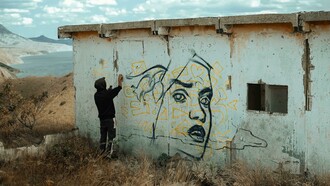Writing (1), since its beginnings, has always been in the fore of the artistic debate. Lately it is hitting also the cultural and even the political headlines, against its own will. Basically, there are two open questions at stake: illegality, which is at the base of the action and the level of urban blight that results from it. Vandalism is the most frequent accusation for the protagonists of this movement.
It is necessary to focus on methodological issues before undertaking a profound reflection about the practices and poetics of Writing. The objectives of such an approach are manifold and range from recognition of some essential characters of the movement to a questioning of the artistic value of any work of a writer.
It is not my intention to bring the debate on a social or political level in which the central node would be the identification of a boundary between the creative act and the act of vandalism. Rather, it is interesting and, in some respects, inevitable to notice how the same protagonists of Writing - from the so-called founding fathers to the younger members - tend to define their actions and their movement as a “discipline” and not as an art form. This stems in part from attempts, almost always made in retrospect, to describe Writing and to be able to draw up an agreed definition that could embrace at the same time the Official History and the Truth about its birth and diffusion (2).
Claiming that Writing is a discipline, a form of expression, a language (3) and not a movement or an artistic trend (comparable to other "isms" of the Twentieth Century) allows a terminological inclusive approach, that can encompass those which today appear almost as distinct elements: from the tag to throw-up to the piece (4). If it is true that often the path of each individual writer mimics the germ process that in the 70s saw the very development of Writing - starting from the simple writing of tags -, it is equally true that in the following forty years many new directions have emerged, giving birth to the extraordinary current panorama.
If we borrow two terms from evolutionary biology, we could identify in Writing the existence of a phylogenetic path, which goes from the appearance of the first signs in Philadelphia and New York to current developments of the discipline, and a great variety of ontogenetic developments - as many of them as individual writers - in which we can recognize the evolutionary process. Leaving metaphor aside, the explanation is very simple: Writing behaves like a seed that once planted in a given soil sprouts, grows and is able to develop special characteristics which combine the existing genes with the environment where it is located.
Extract from Don't Call It Art!, by Claudio Musso, in FRONTIER. The line of style. Damiani Editore, 2012.
Notes:
(1)The decision to use the term Writing in place of Graffiti, comes from the need to make a clarification that is respectful first of all of the intentions of writers, those who have created this language.
(2) Many writers’ opinions are now also on the Internet, but this book remains a point of reference Style: Writing from Underground. (R)evolution of Aerosol Linguistics, Stampa Alternativa in Association with IGTimes, Terni 2008 [1996].
(3) Here the term ‘language’ is used with the meaning of «communication tool used by members of a community».
(4) Regarding the analysis of the practices of Writing see Daniela Lucchetti, Writing. Storia, linguaggi, arte nei graffiti di strada, Castelvecchi, Rome 1999 or the recent Anna Waclawek, Graffiti and Street Art, Thames & Hudson, London 2011.














